I've had a look around at all the various different ways to build a Full Adder and decided to have a crack at it myself. I looked at what it consisted of (2 XOR gates and a few AND gates) and built a model from diagrams of the gates that I managed to find. After having built this model I tested it and funnily enough it doesn't work.
Now, I can't see where I went wrong in this as according to my logic it should work perfectly. The only thing that I see that could be happening is that there is a leakage from the base to the emitter of all my AND gates.
This is the diagram of what I've built:
 I've used 2N3904, which are BJT NPN transistors. I'm not using a ACS713 on the real thing but that was the only image that I could find that was close to what I wanted. The input voltage is 5V with a 1k Ohm resistor.
I've used 2N3904, which are BJT NPN transistors. I'm not using a ACS713 on the real thing but that was the only image that I could find that was close to what I wanted. The input voltage is 5V with a 1k Ohm resistor.
Can someone please help me to figure out what is wrong with this model and potentially give me some improvements?
Thanks in advance.